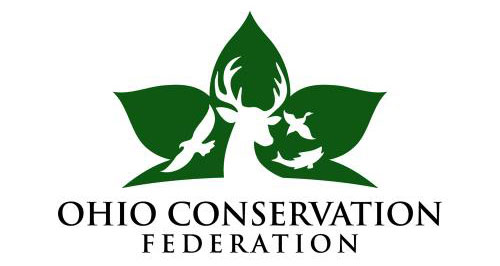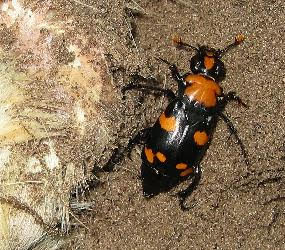The American burying beetle (Nicrophorus americanus) is a very unique species of insect that buries vertebrate carcasses on which to lay their eggs and exhibits parental care for their offspring. At night, a mated pair of two-inch, black and orange-red beetles, when encountering an appropriately sized dead animal (3-7 ounces), work together to excavate a hole in the soil and bury the remains. Once underground, the female lays her eggs, and the pair has about six days to prepare the carcass by removing the hair or feathers, rolling it into a ball, and treating the exterior with secretions to slow the growth of bacteria and mold. When successful, 12-18 eggs will hatch and begin to develop as larvae, but if too many are present, the female will cannibalize the excess to increase the chance of success of those remaining to match the available resources. Larvae are dependent upon the regurgitation of food by both parents for the first 10-15 days of their lives. This level of parental care is rare in the insect world, but after 15 days mom encourages dad to leave so the young can continue their development to adulthood on what remains of the carrion. Depending upon temperature, the complete process can take anywhere from 30-65 days. A female will have at most three broods in her 12-18-month lifetime.
At one time, American burying beetles were found in 35 states, covering most of temperate eastern North America. Their success and struggles paralleled and were preceded by another species, the Passenger pigeon. From the 1850’s to the 1890’s, the Passenger pigeon population plummeted from numbers in the billions to virtual extinction, succumbing to the powerful impacts that the telegraph and the steam train had on habitat loss, nesting disruption, and commercial hunting. The offspring of those pigeons in the middle 19th century, that died before adulthood, provided a rich food source on which burying beetle parents could raise their young. On September 1st, 1914 the last Passenger pigeon, named Martha, died in the Cincinnati zoo and the Passenger pigeon species was officially extinct. In the summer of 1989, struggling to remain in existence despite habitat loss, the broad use of insecticides, and competition for scarce carcasses, the American burying beetle (ABB) was formally listed for protection under the Endangered Species Act (ESA) of 1973.
The ESA, signed into law by President Nixon, had nearly unanimous bipartisan support. It passed the U.S. Senate by 92-0 with 53 democrats and 37 republicans voting yea and the U.S. House by a vote of 390-12 with 219 democrats and 170 republicans in support. The text of the ESA is relatively short, a mere 49 pages. The very first words, besides the table of contents, identify the problem;
The Congress finds and declares that various species of fish, wildlife, and plants in the United States have been rendered extinct as a consequence of economic growth and development untempered by adequate concern and conservation;
and soon thereafter establishes the purpose of the act;
The purposes of this Act are to provide a means whereby the ecosystems upon which endangered species and threatened species depend may be conserved, to provide a program for the conservation of such endangered species and threatened species, and to take such steps as may be appropriate to achieve the purposes of the treaties and conventions set forth in subsection (a) of this section.
This summer, the Trump administration, in an effort to reportedly “modernize”, “improve” and “increase transparency” of the ESA, issued a new set of rules regarding the enforcement of the act. There are two primary changes, the first of which prohibits the need to consider the impacts of longer-term climate change on species under consideration and the second instructs the agencies to assess the economic consequences of protecting species. Opponents use words like “breathtaking” and “illegal” to describe the changes that they see as catering to oil and gas interests and ultimately weakening protections for our most vulnerable species.
Under the Carter, Reagan, and Bush administrations, the United States Congress passed amendments, that toggled back and forth aspects of protection, including providing for exemptions by a cabinet-level committee (1978), prohibiting consideration of possible economic effects (1982), requirement of public notice, consideration of public comment, reporting of expenditures (1988), and permitting the Department on Defense certain exemptions from critical habitat designations (2004). Even President Obama, who was generally credited with actions supportive of the ESA, also felt the lobbying pressure from industry and developers and on his way out the door was criticized for weakening protections for critical habitats and increasing limits on “incidental takes” of protected species. In some circles, these most recent regulatory changes are seen simply as relatively toothless attempts to appear to placate those that oppose the ESA, because at its core the ESA remains intact and directs the Administration to obey the “best science” or else risk the inevitable legal challenges. With polling repeatedly showing that 80% of Americans support the ESA, congress has shown very little desire to act. And ultimately, Congress holds the purse strings that fund the protection efforts and recovery plans.
Since 1973, more than 1600 plant and animal species worldwide have been recognized by the ESA and about 1200 have had recovery plans developed. Of those, 99% have avoided extinction. Eighty-five species, including the Bald eagle, Humpback whale, American alligator and Lake Erie water snake have been recovered and de-listed. From these perspectives, the ESA has been viewed as successfully decreasing the loss of species diversity at the hands of “untempered” development and growth.
This past spring, as a result of the efforts of scientists and citizens (and no small amount of lobbying by the oil and gas industry), the ABB was recommended for reclassification from endangered to threatened. The recovery plan developed by the U.S. Fish and Wildlife Service in 1991 described success as having three secure, self-sustaining populations of five hundred or more ABB in each of four different geographical areas across its historical range for five consecutive years. Efforts to protect habitats and experimental reintroductions including areas in Ohio like Waterloo Wildlife Area, Wildcat Hollow, the Wilds, and the Fernald Preserve (once the site of military-grade uranium ore processing just north of Cincinnati) have had a positive impact. The resurgence of turkeys (specifically their poults) once again provides extra sources of carrion for beetles to bury. And, it’s possible that trappers have played a role too. Nationwide, over the past 30 years, the population of raccoons and skunks have increased dramatically as have the ranges of coyotes and opossums. Population control of these common competitive species by trappers may have helped to level the playing field for the ABB and contributed to its current success and potential down-listing.
To learn more about the American burying beetle or the Endangered Species Act, check out the three online resources below. And, thanks for reading!
Proposal to Reclassify the American Burying Beetle:
U.S. Fish & Wildlife Service ESA website:
https://www.fws.gov/endangered/
A searchable database of endangered species:


